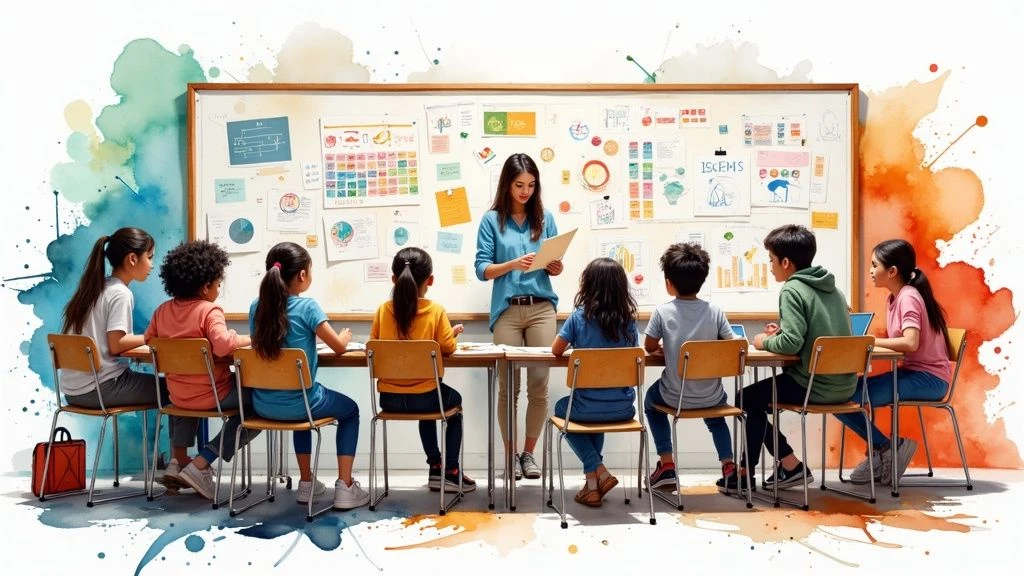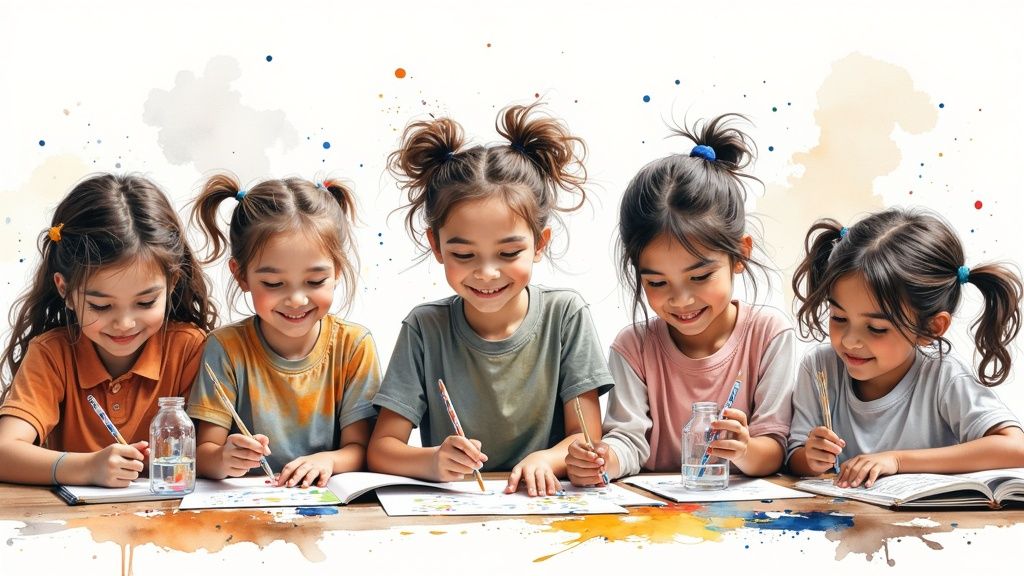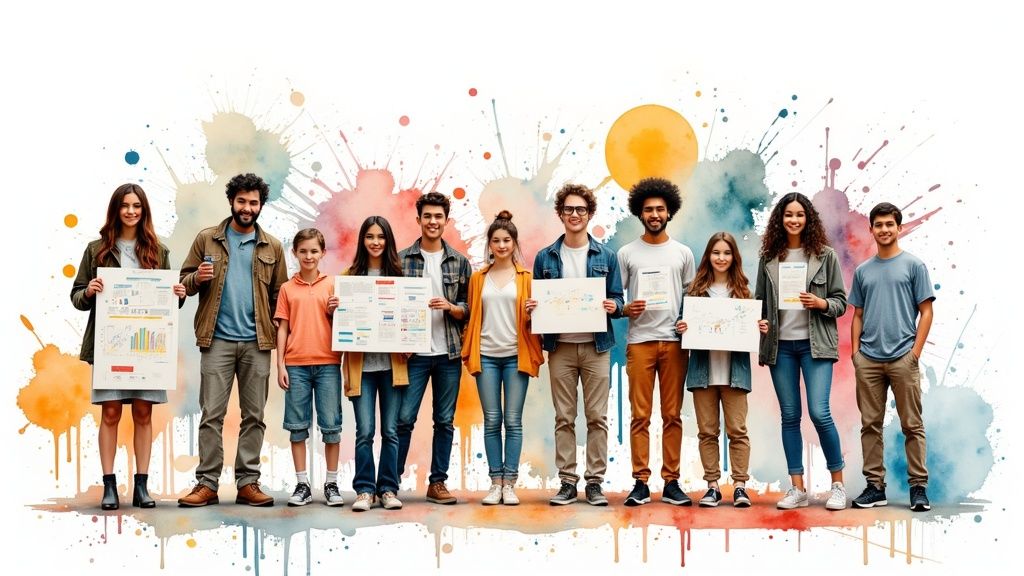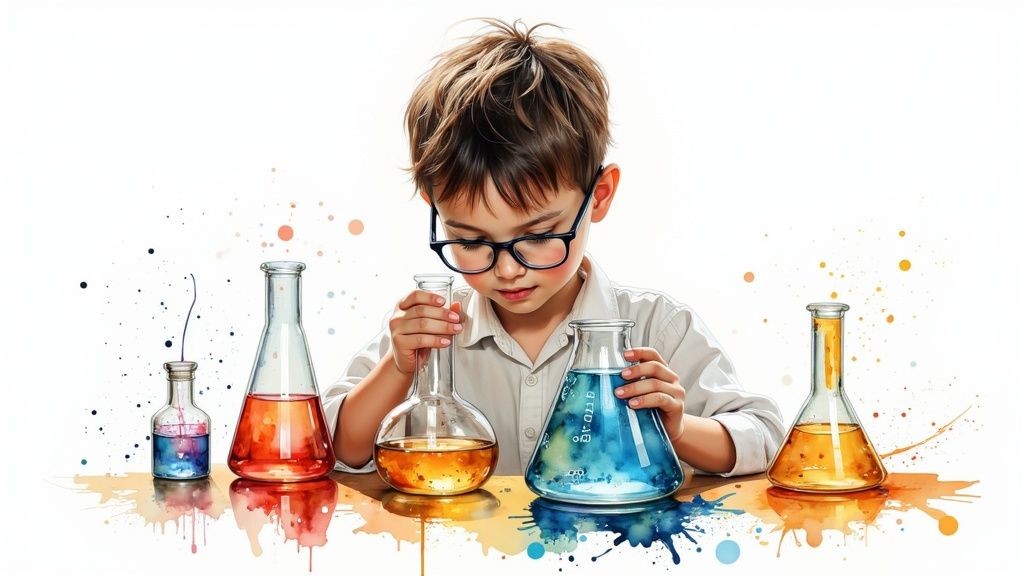15 Project Based Learning Ideas That Transform Student Success & Engagement
February 16, 2025

Understanding the Power of Project Based Learning
Project Based Learning (PBL) fundamentally changes how students absorb and retain information. Rather than sitting passively and memorizing facts, students dive into hands-on projects that matter in the real world. This natural approach to learning helps information stick and makes more sense to students.
How PBL Fosters Deeper Learning
Through PBL, students become active investigators instead of passive listeners. They explore real issues, ask meaningful questions, and work to find solutions. For instance, rather than just memorizing historical dates, students might research an event and create their own documentary about it. This hands-on experience builds a richer understanding of the subject matter.
Students also learn essential teamwork skills through PBL. Working in groups, they share different viewpoints, discuss ideas, and learn from their peers - just like they'll need to do in their future careers. Want to learn more? Check out: How to master student engagement strategies.
The Impact of PBL on Student Outcomes
Research clearly shows the benefits of project-based learning. The Project Tomorrow's 2019-20 Speak Up Project conducted a major study involving 137,000 K-12 students, teachers, and administrators. The results were clear: 80% of principals who used PBL across their schools saw improved academic performance, while 69% reported better understanding of core subjects. Learn more in the full report: The State of Project Based Learning.
Implementing PBL Effectively
The key to successful PBL lies in finding the right balance between student independence and teacher guidance. Teachers serve as coaches, offering support while letting students take charge of their learning. This includes setting clear goals, providing helpful resources, and creating a space where students feel safe to experiment and learn from mistakes.

PBL goes beyond simply adding a project to the end of a lesson. It weaves projects naturally throughout the learning process. This approach not only keeps students interested but also helps them develop a genuine love for learning. By giving students an active role in their education, PBL helps prepare them for whatever challenges they'll face in the future.
Innovative STEM Projects That Drive Real Learning

The most effective STEM education happens through hands-on projects that capture students' interest and curiosity. When students work on real projects, they develop core scientific and technical abilities while discovering the excitement of exploration. Active participation leads to deeper understanding and lasting impact.
Integrating Real-World Problem Solving
The best STEM projects connect directly to actual challenges in students' lives and communities. For example, students might create an energy conservation plan for their school building or develop solutions for local water quality issues. This practical approach helps students grasp complex ideas by seeing how they apply in meaningful situations. When students tackle real problems, they understand why STEM skills matter.
Working With Modern Tools
Today's STEM projects give students hands-on experience with professional tools and technologies. Students use 3D printers to build prototypes, program robots to complete specific tasks, and work with data analysis software to understand scientific results. These practical skills prepare them for future opportunities in STEM careers.
Building Community Partnerships
Learning extends beyond classroom walls through partnerships with local organizations. Working alongside professionals gives students authentic experience solving real challenges. These connections introduce students to potential careers and mentors in STEM fields. Research shows the impact - one study found that guided project-based learning in statistics courses led to better grades and increased student interest. Learn more in this detailed research study.
Assessing Project Based Learning
Measuring success in project-based learning requires looking beyond test scores. Teachers evaluate students' problem-solving abilities, teamwork, communication skills, and creative thinking. Good assessment provides helpful feedback while helping teachers improve their project designs. This ensures students get the most benefit from their hands-on STEM experiences.
Cross-Curricular Projects That Ignite Creative Thinking

Teachers are discovering the power of connecting different subjects through engaging project based learning. When students see how math, science, writing and other topics relate to each other, they develop deeper understanding and better problem-solving skills. These multi-subject projects bring learning to life in meaningful ways.
Breaking Down Subject Silos
Most schools teach subjects separately, but real problems don't fit into neat categories. A project about local water quality shows how different subjects naturally connect - students can test water samples (science), analyze the data (math), and research how it affects their community (social studies). This helps students see how their skills and knowledge work together.
Collaboration and Creative Thinking
When teachers team up across departments, amazing things happen. Students benefit from different teaching styles while working toward shared goals. The variety of perspectives helps spark new ideas and builds stronger connections between students and teachers. Want to explore more ways to boost creativity? Check out: Powerful Creative Thinking Exercises to Unlock Innovation Potential.
Practical Strategies for Implementation
To run successful cross-subject projects, consider these key steps:
- Plan the framework: Set clear goals, timelines and grading criteria for each subject area
- Keep communication open: Schedule regular check-ins between teachers to stay coordinated
- Make time for deeper learning: Adjust schedules to allow for extended project work periods
- Assess the whole picture: Grade both subject knowledge and skills like teamwork
The Impact on Statistical Literacy and Other Skills
Research shows these projects boost unexpected skills too. A study of 70 eighth-grade students in Turkey found that project-based learning significantly improved statistical literacy compared to traditional teaching. See the full research here: Find more detailed statistics here. By connecting subjects naturally, students develop practical skills they'll use throughout their lives. This approach helps them love learning and prepares them for real-world challenges ahead.
Building Community Through Project Based Learning

When students tackle real community challenges through hands-on projects, something amazing happens. They don't just learn - they become active citizens making a real difference. By connecting classroom learning to local needs, students develop skills while creating positive change.
Establishing Authentic Community Partnerships
The best projects start with strong local connections. Teachers reach out to neighborhood organizations, small businesses, and local agencies to find genuine ways students can help. Some great examples include students designing new playground equipment with parks departments, organizing food drives with local pantries, or creating oral history projects with senior centers. These partnerships give learning real meaning and purpose.
Managing Complex Projects in the Community
Let's be honest - community projects can get messy with lots of moving parts and people involved. Good planning makes all the difference. Breaking big tasks into smaller chunks helps students stay organized. Clear communication with community partners is key - regular check-ins help catch issues early and keep everything running smoothly.
Measuring Impact: Academic and Community Outcomes
Success means looking at both student growth and community benefits. Teachers use student reflections, partner feedback, and hard data to evaluate projects. For instance, a park improvement project might track visitor numbers before and after. According to a recent study, project-based learning shows strong results across different student groups. Learn more in this research overview: New Research Makes Powerful Case for PBL.
Ensuring Student Safety and Sustainability
Student safety comes first in community work. This means getting proper permissions, providing supervision, and teaching safe practices. Projects should also create lasting positive change. The best initiatives live on through future classes of students. When safety and sustainability guide the way, everyone benefits - students grow while making their community better.
Making Digital Tools Work for Projects
Project based learning shines when students collaborate and think creatively. The right digital tools can help students plan, create, and showcase their work more effectively. Let's explore some key tools that can support successful project based learning.
Tools That Help Teams Work Together
Good teamwork makes projects succeed. Digital tools let students collaborate easily, whether they're in the same room or working remotely. Google Workspace tools like Docs and Slides allow students to edit together in real time and give each other feedback. Chat platforms like Slack or Microsoft Teams help keep project discussions organized and everyone in the loop. This way, teams stay connected and projects move forward smoothly.
Better Ways to Create and Present
Students can now make impressive multimedia projects that go beyond basic presentations. With video editors like Adobe Premiere Rush or iMovie, students can create their own documentaries or explainer videos. Design tools like Canva make it simple to create eye-catching posters and graphics. These options give students more ways to show what they've learned.
Keeping Projects Organized
Complex projects need good organization to track tasks and deadlines. Tools like Trello or Asana give students a clear view of who's doing what and when things are due. These tools teach students valuable planning skills they'll use in future jobs. Plus, they help keep everyone focused on their tasks.
Making Feedback and Grading Easier
Digital tools simplify how teachers assess work and give feedback. Learning platforms like Google Classroom or Canvas let teachers create tests, collect work, and give personal feedback all in one place. Digital portfolios help students gather their best work and see how they've grown. Read more about this in our guide to digital transformation in education.
Picking the Right Tools
With so many digital tools available, it's important to choose wisely. Look for tools that:
- Match your project goals
- Fit your budget
- Work well with tools you already use
- Are easy for students to learn
Remember, digital tools should make projects better, not more complicated. Take time to find the right tools that help students learn without creating extra work.
Measuring Success in Project Based Learning
Learning happens in many different ways, and project based learning (PBL) needs its own special way of measuring student growth. Let's explore how we can effectively track progress when students learn through hands-on projects.
Creative Ways to Measure Growth
One approach that works well is using detailed rubrics. Think of rubrics as roadmaps that show students exactly what success looks like. They help teachers fairly evaluate important skills like teamwork, problem-solving, and creative thinking. When students understand what's expected, they're more likely to hit their goals.
Students can also take charge of their own learning through self-assessment. When kids regularly think about their work and progress, they become better at spotting their strengths and figuring out where they need more practice. This kind of reflection helps them own their learning journey.
Finding the Sweet Spot Between Structure and Freedom
Getting the balance right between academic goals and creative freedom matters a lot in project work. Peer feedback can be really helpful here - when students review each other's work, they practice giving constructive comments and learn from seeing different approaches. It's similar to how people collaborate and share ideas in real jobs.
Teachers can also keep track of progress using portfolios. These collections of student work tell the story of how a student grows over time, showing both their finished projects and how they got there.
Making Assessment Work for Your Classroom
Teachers can shape their evaluation methods to match their specific classroom needs and project goals. By adjusting how they measure success, teachers can make sure they're tracking what really matters for their students. This approach helps show how students use their knowledge in real-world situations.
Here's a practical example: If students are designing a community garden, their grade might include how well they understand plant growth cycles, their garden layout skills, and how clearly they present their ideas to the community. This kind of assessment captures learning that traditional tests might miss.
Using Assessment to Build Excitement
The best kind of assessment gets students excited about learning more. When students feel their work is being evaluated in meaningful ways, they tend to put in more effort and show more interest. Assessment should celebrate growth and encourage students to tackle new challenges.
Remember that good assessment in PBL helps students learn and grow while staying motivated. If you're looking to add some creativity to your projects, check out ColorPageAI for educational visuals that can bring your lessons to life.
Ready to start coloring?
Join ColorPage.ai today and get 5 free credits to create your own custom coloring pages!
Start creating